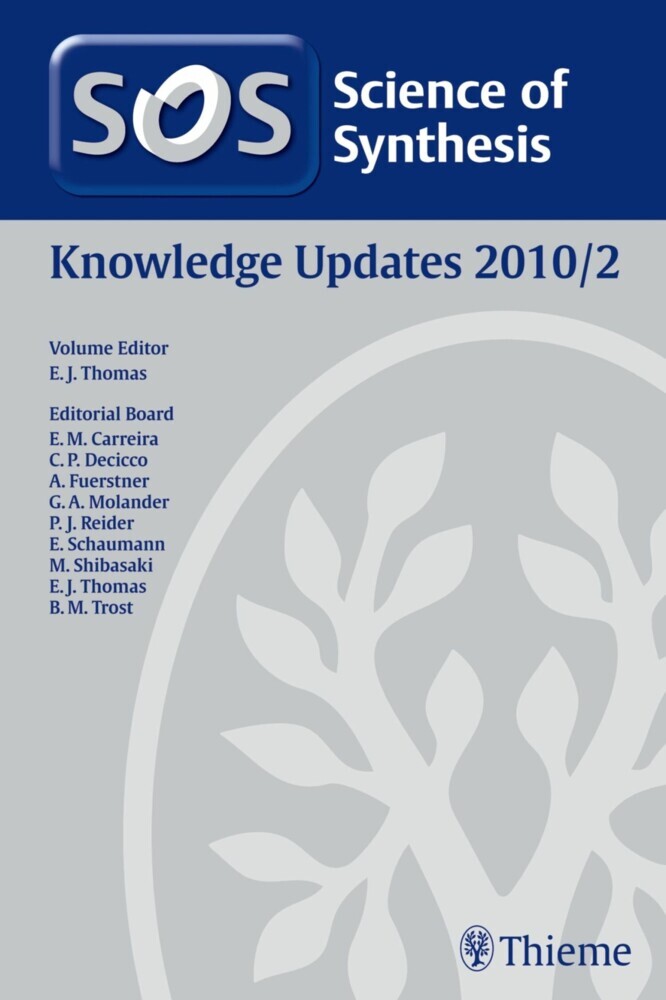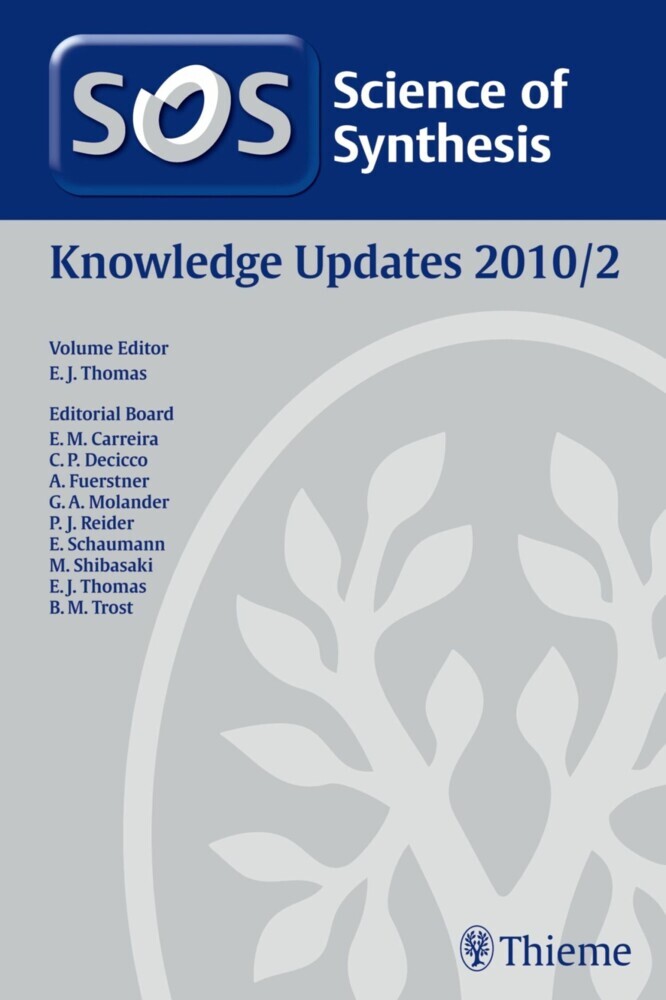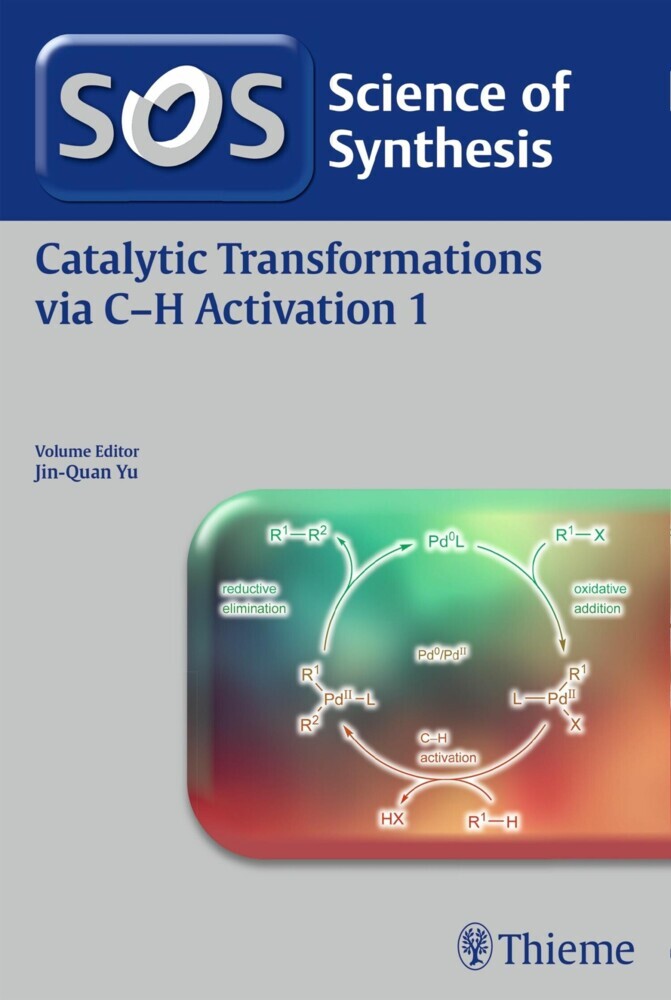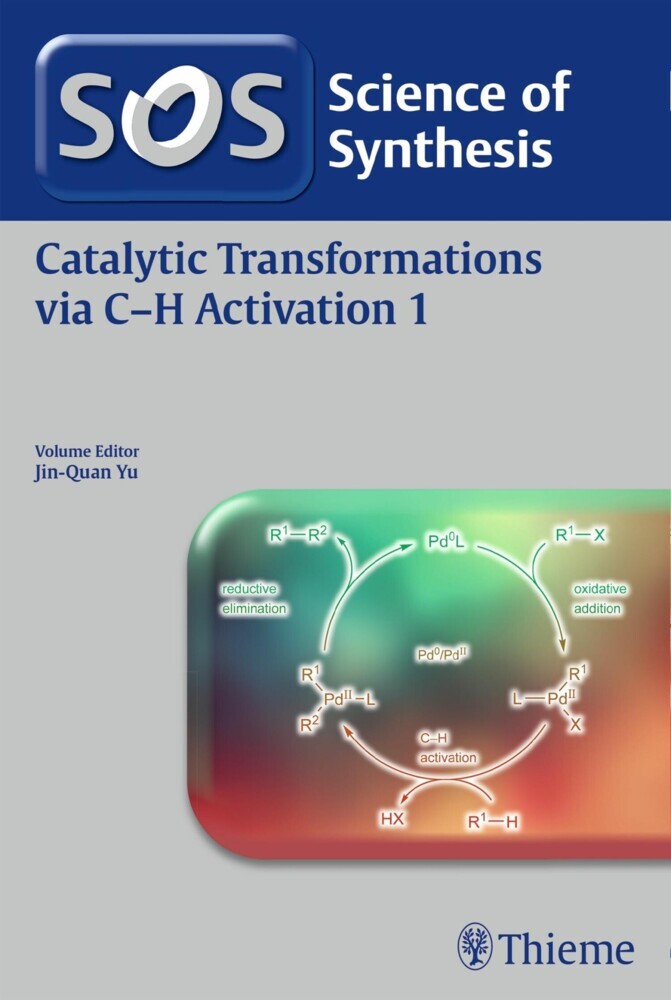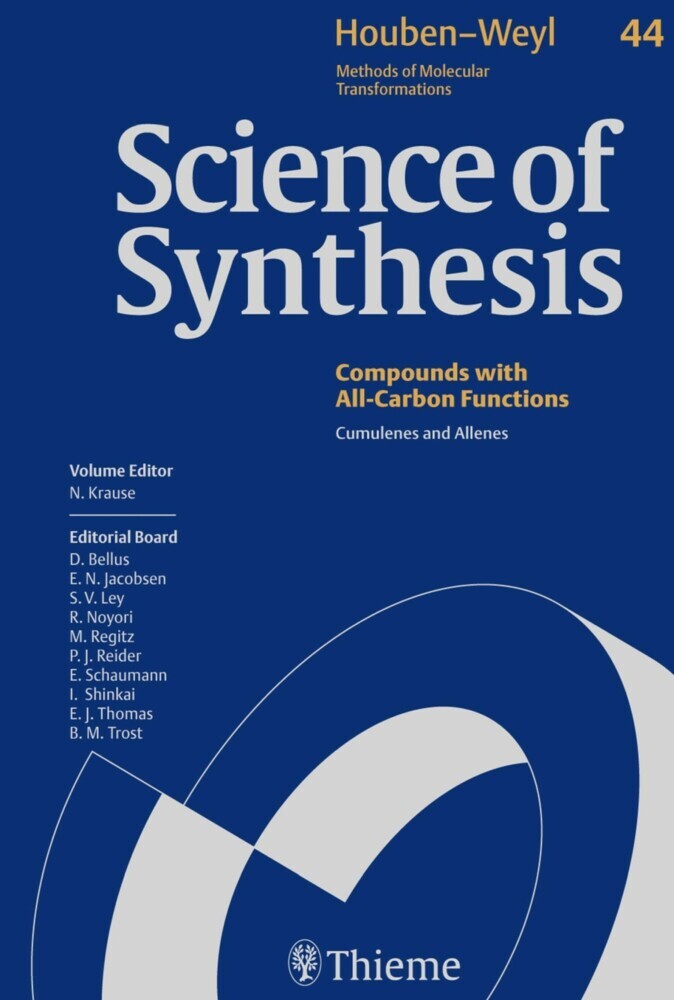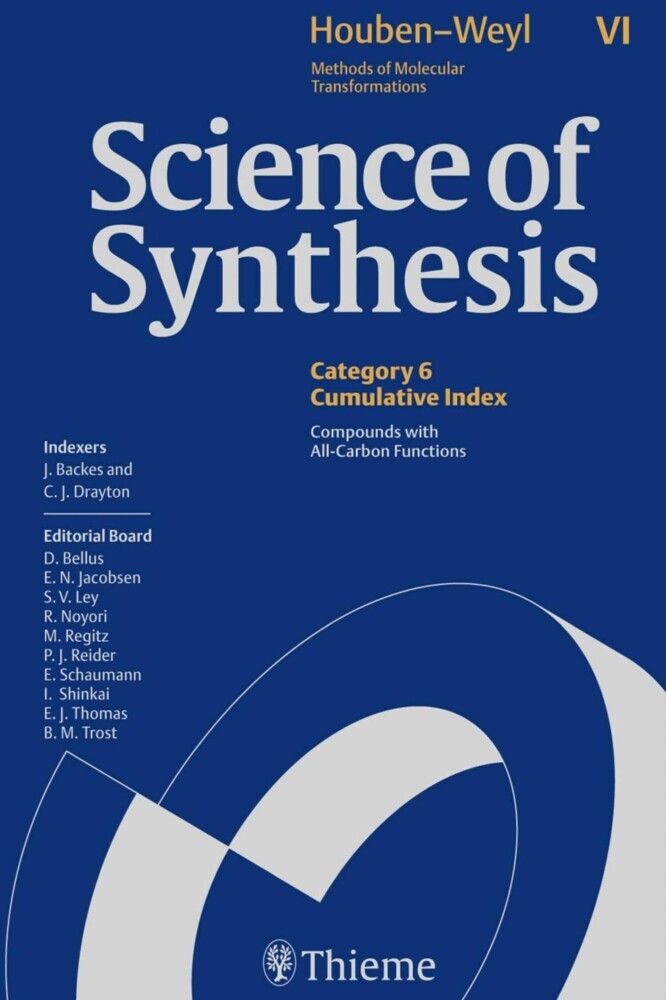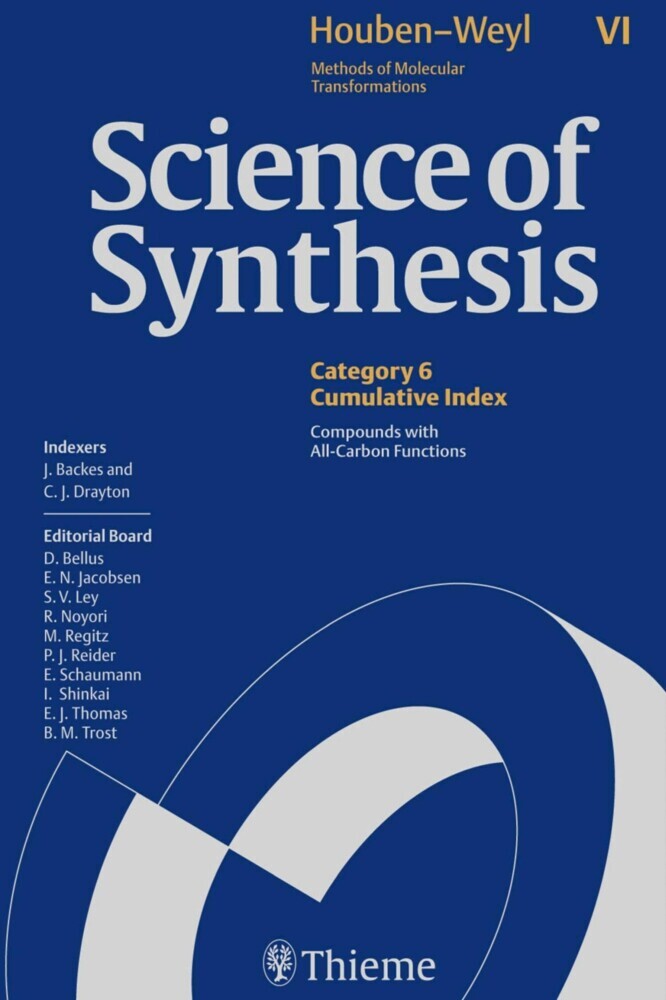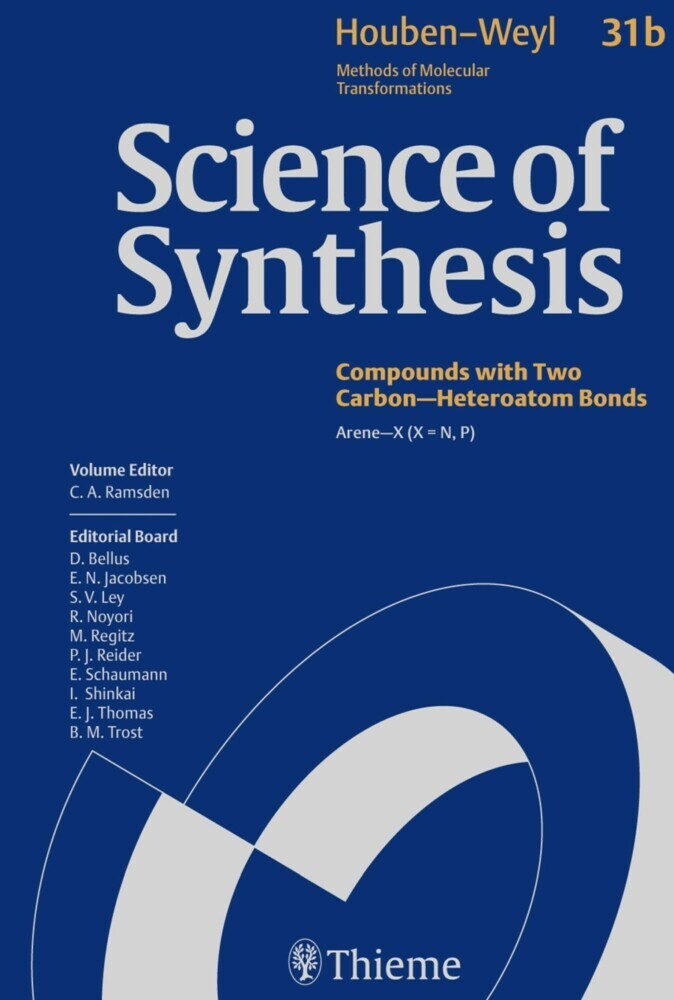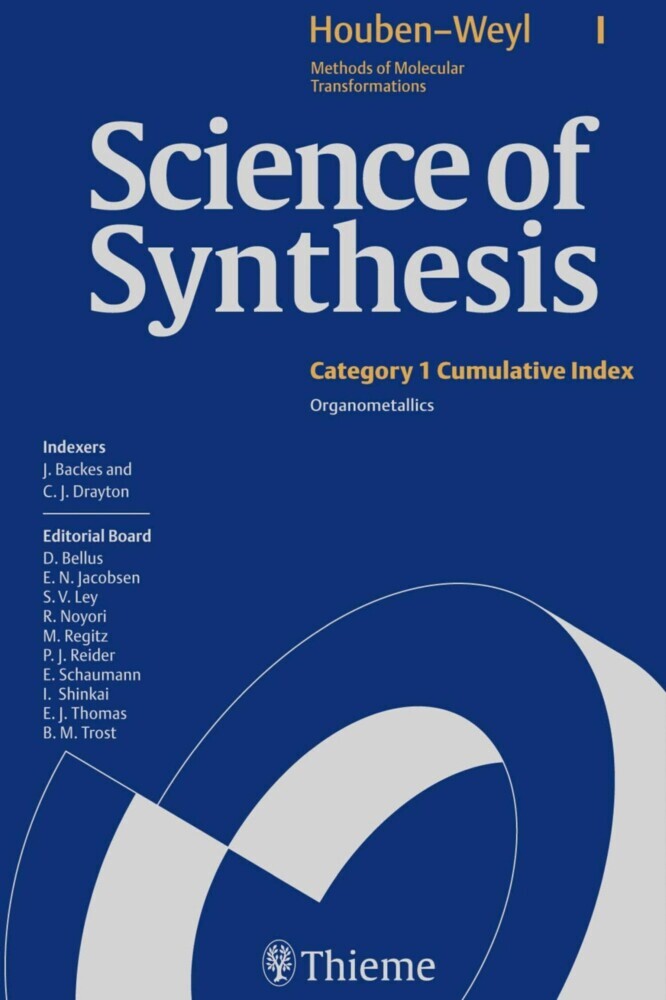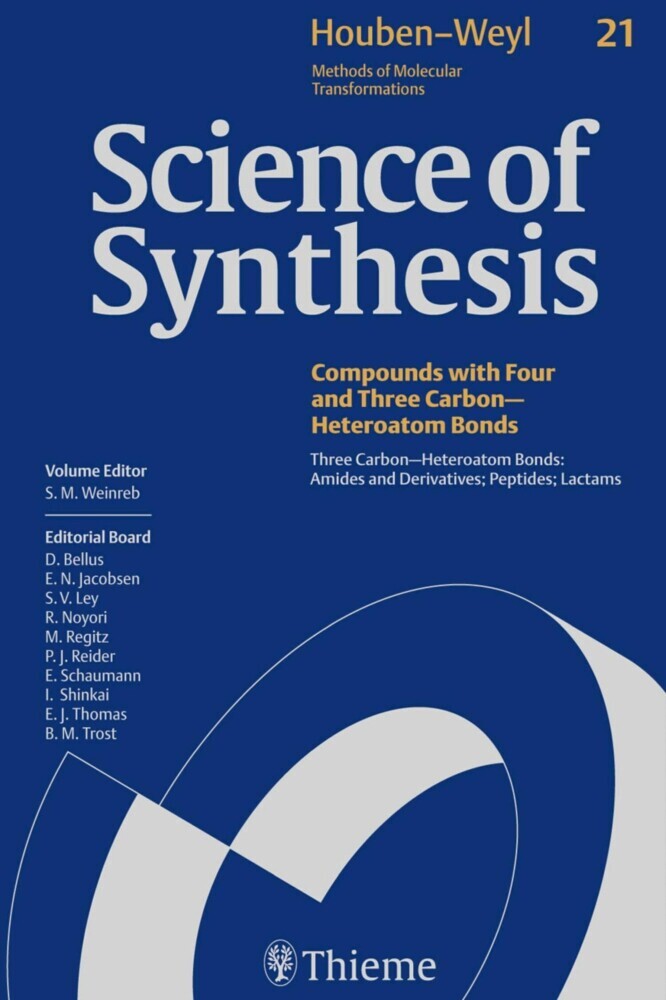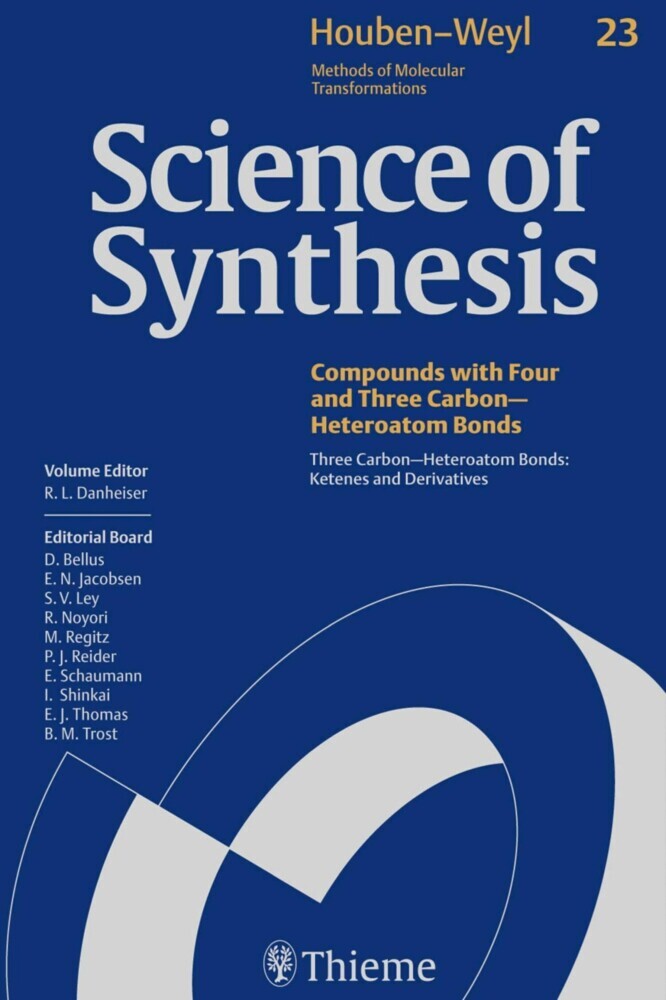Science of Synthesis Knowledge Updates 2010 Vol. 2
The Science of Synthesis Editorial Board,together with the volume editors and authors, is constantly reviewing the whole field of synthetic organic chemistry as presented in Science of Synthesis and evaluating significant developments in synthetic methodology. Four annual volumes updating content across all categories ensure that you always have access to state-of-the-art synthetic methodology.
Content of this volume: Indole and Its Derivatives, 1H-Indol-1-ols (1-Hydroxy-1H-indoles), 1,3-Dihydro-2H-indol-2-ones (1H-Indol-2-ols, 2-Hydroxy-1H-indoles, or Oxindoles), 1,2-Dihydro-3H-indol-3-ones (1H-Indol-3-ols, 3-Hydroxy-1H-indoles, or Indoxyls), 1H-Indole-2,3-diones (Isatins).
1;Science of Synthesis: Knowledge Updates 2010/2;1 1.1;Title page;5 1.2;Imprint;7 1.3;Preface;8 1.4;Abstracts;10 1.5;Overview;12 1.6;Table of Contents;14 1.7;Volume 10: Fused Five-Membered Hetarenes with One Heteroatom;24 1.7.1;10.13 Product Class 13: Indole and Its Derivatives;24 1.7.1.1;10.13.1 Product Subclass 1: Indoles;24 1.7.1.1.1;10.13.1.1 Synthesis by Ring-Closure Reactions;29 1.7.1.1.1.1;10.13.1.1.1 By Annulation to an Arene;29 1.7.1.1.1.1.1;10.13.1.1.1.1 By Formation of Two N--C Bonds and One C--C Bond;29 1.7.1.1.1.1.1.1;10.13.1.1.1.1.1 With Formation of 1--2, 1--7a, and 3--3a Bonds;29 1.7.1.1.1.1.1.1.1;10.13.1.1.1.1.1.1 Method 1: From 1,2-Dihaloarenes;29 1.7.1.1.1.1.2;10.13.1.1.1.2 By Formation of Two N--C Bonds;30 1.7.1.1.1.1.2.1;10.13.1.1.1.2.1 With Formation of 1--2 and 1--7a Bonds;30 1.7.1.1.1.1.2.1.1;10.13.1.1.1.2.1.1 Method 1: From 2-(2-Haloalkenyl)haloarenes;30 1.7.1.1.1.1.2.1.2;10.13.1.1.1.2.1.2 Method 2: From 2-(2-Haloaryl)oxiranes;32 1.7.1.1.1.1.2.1.3;10.13.1.1.1.2.1.3 Method 3: From (2-Haloaryl)alkynes;33 1.7.1.1.1.1.3;10.13.1.1.1.3 By Formation of One N--C and One C--C Bond;35 1.7.1.1.1.1.3.1;10.13.1.1.1.3.1 With Formation of 1--2 and 3--3a Bonds;35 1.7.1.1.1.1.3.1.1;10.13.1.1.1.3.1.1 Method 1: From Arylhydrazones; Fischer Synthesis;35 1.7.1.1.1.1.3.1.1.1;10.13.1.1.1.3.1.1.1 Variation 1: From 4-Chlorobutanal and Arylhydrazines; Grandberg Tryptamine Synthesis;52 1.7.1.1.1.1.3.1.1.2;10.13.1.1.1.3.1.1.2 Variation 2: From ß-Oxo Esters and Arenediazonium Ions; Japp-Klingemann Synthesis;53 1.7.1.1.1.1.3.1.1.3;10.13.1.1.1.3.1.1.3 Variation 3: From Nb-Aryl Benzophenone Hydrazones and Ketones;58 1.7.1.1.1.1.3.1.1.4;10.13.1.1.1.3.1.1.4 Variation 4: From Alkynes and Arylhydrazines;60 1.7.1.1.1.1.3.1.1.5;10.13.1.1.1.3.1.1.5 Variation 5: From Alkenes via Hydroformylation;62 1.7.1.1.1.1.3.1.2;10.13.1.1.1.3.1.2 Method 2: From O-Alkenyl N-Arylhydroxylamines;64 1.7.1.1.1.1.3.1.3;10.13.1.1.1.3.1.3 Method 3: From ortho-Substituted Nitroarenes; Bartoli Synthesis;69 1.7.1.1.1.1.3.1.4;10.13.1.1.1.3.1.4 Method 4: From Arylamines and Alkylsulfanylmethyl Ketones; Gassman Indole Synthesis;72 1.7.1.1.1.1.3.1.5;10.13.1.1.1.3.1.5 Method 5: From Arylamines and Ketones;74 1.7.1.1.1.1.3.1.6;10.13.1.1.1.3.1.6 Method 6: From o-Haloarylamines and Ketones or Aldehydes;74 1.7.1.1.1.1.3.1.7;10.13.1.1.1.3.1.7 Method 7: From Arylamines and 1,2-Diols;77 1.7.1.1.1.1.3.1.8;10.13.1.1.1.3.1.8 Method 8: From Arylamines and a-Halo Ketones; Bischler Synthesis;78 1.7.1.1.1.1.3.1.9;10.13.1.1.1.3.1.9 Method 9: From o-Haloarylamines and Alkynes;79 1.7.1.1.1.1.3.1.9.1;10.13.1.1.1.3.1.9.1 Variation 1: Larock Synthesis;79 1.7.1.1.1.1.3.1.9.2;10.13.1.1.1.3.1.9.2 Variation 2: With Concomitant Introduction of a 3-Substituent;86 1.7.1.1.1.1.3.1.9.3;10.13.1.1.1.3.1.9.3 Variation 3: Using a Copper Catalyst;87 1.7.1.1.1.1.3.1.9.4;10.13.1.1.1.3.1.9.4 Variation 4: Using Hydroamination;88 1.7.1.1.1.1.3.1.9.5;10.13.1.1.1.3.1.9.5 Variation 5: Using Allenes;89 1.7.1.1.1.1.3.1.10;10.13.1.1.1.3.1.10 Method 10: From N-Acyl-o-bromoarylamines and a-Halo Ketones;90 1.7.1.1.1.1.3.1.11;10.13.1.1.1.3.1.11 Method 11: From ortho-Thallated N-Acylarylamines and 3-Chloroprop-1-ene;91 1.7.1.1.1.1.3.1.12;10.13.1.1.1.3.1.12 Method 12: From N-Alkyl-N-arylhydroxylamines and Alkynes Carrying Electron-Withdrawing Groups;92 1.7.1.1.1.1.3.1.13;10.13.1.1.1.3.1.13 Method 13: From N-Sulfinylarylamines and Grignard Reagents;93 1.7.1.1.1.1.3.1.14;10.13.1.1.1.3.1.14 Method 14: From N-Arylarenesulfonamides and Phenyl(propynyl)iodonium Trifluoromethanesulfonate;93 1.7.1.1.1.1.3.1.15;10.13.1.1.1.3.1.15 Method 15: From Nitroarenes;94 1.7.1.1.1.1.3.1.16;10.13.1.1.1.3.1.16 Method 16: From N-Propargylanilines;94 1.7.1.1.1.1.3.1.17;10.13.1.1.1.3.1.17 Method 17: From o-Bromoiodoarenes;95 1.7.1.1.1.1.3.1.18;10.13.1.1.1.3.1.18 Method 18: From Anilines and Alkynes;95 1.7.1.1.1.1.3.1.19;10.13.1.1.1.3.1.19 Method 19: From Aniline and Epoxides;96 1.7.1.1.1.1.3.2;10.13.1.1
1;Science of Synthesis: Knowledge Updates 2010/2;1
1.1;Title page;5
1.2;Imprint;7
1.3;Preface;8
1.4;Abstracts;10
1.5;Overview;12
1.6;Table of Contents;14
1.7;Volume 10: Fused Five-Membered Hetarenes with One Heteroatom;24
1.7.1;10.13 Product Class 13: Indole and Its Derivatives;24
1.7.1.1;10.13.1 Product Subclass 1: Indoles;24
1.7.1.1.1;10.13.1.1 Synthesis by Ring-Closure Reactions;29
1.7.1.1.1.1;10.13.1.1.1 By Annulation to an Arene;29
1.7.1.1.1.1.1;10.13.1.1.1.1 By Formation of Two N--C Bonds and One C--C Bond;29
1.7.1.1.1.1.1.1;10.13.1.1.1.1.1 With Formation of 1--2, 1--7a, and 3--3a Bonds;29
1.7.1.1.1.1.1.1.1;10.13.1.1.1.1.1.1 Method 1: From 1,2-Dihaloarenes;29
1.7.1.1.1.1.2;10.13.1.1.1.2 By Formation of Two N--C Bonds;30
1.7.1.1.1.1.2.1;10.13.1.1.1.2.1 With Formation of 1--2 and 1--7a Bonds;30
1.7.1.1.1.1.2.1.1;10.13.1.1.1.2.1.1 Method 1: From 2-(2-Haloalkenyl)haloarenes;30
1.7.1.1.1.1.2.1.2;10.13.1.1.1.2.1.2 Method 2: From 2-(2-Haloaryl)oxiranes;32
1.7.1.1.1.1.2.1.3;10.13.1.1.1.2.1.3 Method 3: From (2-Haloaryl)alkynes;33
1.7.1.1.1.1.3;10.13.1.1.1.3 By Formation of One N--C and One C--C Bond;35
1.7.1.1.1.1.3.1;10.13.1.1.1.3.1 With Formation of 1--2 and 3--3a Bonds;35
1.7.1.1.1.1.3.1.1;10.13.1.1.1.3.1.1 Method 1: From Arylhydrazones; Fischer Synthesis;35
1.7.1.1.1.1.3.1.1.1;10.13.1.1.1.3.1.1.1 Variation 1: From 4-Chlorobutanal and Arylhydrazines; Grandberg Tryptamine Synthesis;52
1.7.1.1.1.1.3.1.1.2;10.13.1.1.1.3.1.1.2 Variation 2: From ß-Oxo Esters and Arenediazonium Ions; Japp Klingemann Synthesis;53
1.7.1.1.1.1.3.1.1.3;10.13.1.1.1.3.1.1.3 Variation 3: From Nb-Aryl Benzophenone Hydrazones and Ketones;58
1.7.1.1.1.1.3.1.1.4;10.13.1.1.1.3.1.1.4 Variation 4: From Alkynes and Arylhydrazines;60
1.7.1.1.1.1.3.1.1.5;10.13.1.1.1.3.1.1.5 Variation 5: From Alkenes via Hydroformylation;62
1.7.1.1.1.1.3.1.2;10.13.1.1.1.3.1.2 Method 2: From O-Alkenyl N-Arylhydroxylamines;64
1.7.1.1.1.1.3.1.3;10.13.1.1.1.3.1.3 Method 3: From ortho-Substituted Nitroarenes; Bartoli Synthesis;69
1.7.1.1.1.1.3.1.4;10.13.1.1.1.3.1.4 Method 4: From Arylamines and Alkylsulfanylmethyl Ketones; Gassman Indole Synthesis;72
1.7.1.1.1.1.3.1.5;10.13.1.1.1.3.1.5 Method 5: From Arylamines and Ketones;74
1.7.1.1.1.1.3.1.6;10.13.1.1.1.3.1.6 Method 6: From o-Haloarylamines and Ketones or Aldehydes;74
1.7.1.1.1.1.3.1.7;10.13.1.1.1.3.1.7 Method 7: From Arylamines and 1,2-Diols;77
1.7.1.1.1.1.3.1.8;10.13.1.1.1.3.1.8 Method 8: From Arylamines and a-Halo Ketones; Bischler Synthesis;78
1.7.1.1.1.1.3.1.9;10.13.1.1.1.3.1.9 Method 9: From o-Haloarylamines and Alkynes;79
1.7.1.1.1.1.3.1.9.1;10.13.1.1.1.3.1.9.1 Variation 1: Larock Synthesis;79
1.7.1.1.1.1.3.1.9.2;10.13.1.1.1.3.1.9.2 Variation 2: With Concomitant Introduction of a 3-Substituent;86
1.7.1.1.1.1.3.1.9.3;10.13.1.1.1.3.1.9.3 Variation 3: Using a Copper Catalyst;87
1.7.1.1.1.1.3.1.9.4;10.13.1.1.1.3.1.9.4 Variation 4: Using Hydroamination;88
1.7.1.1.1.1.3.1.9.5;10.13.1.1.1.3.1.9.5 Variation 5: Using Allenes;89
1.7.1.1.1.1.3.1.10;10.13.1.1.1.3.1.10 Method 10: From N-Acyl-o-bromoarylamines and a-Halo Ketones;90
1.7.1.1.1.1.3.1.11;10.13.1.1.1.3.1.11 Method 11: From ortho-Thallated N-Acylarylamines and 3-Chloroprop-1-ene;91
1.7.1.1.1.1.3.1.12;10.13.1.1.1.3.1.12 Method 12: From N-Alkyl-N-arylhydroxylamines and Alkynes Carrying Electron-Withdrawing Groups;92
1.7.1.1.1.1.3.1.13;10.13.1.1.1.3.1.13 Method 13: From N-Sulfinylarylamines and Grignard Reagents;93
1.7.1.1.1.1.3.1.14;10.13.1.1.1.3.1.14 Method 14: From N-Arylarenesulfonamides and Phenyl(propynyl)iodonium Trifluoromethanesulfonate;93
1.7.1.1.1.1.3.1.15;10.13.1.1.1.3.1.15 Method 15: From Nitroarenes;94
1.7.1.1.1.1.3.1.16;10.13.1.1.1.3.1.16 Method 16: From N-Propargylanilines;94
1.7.1.1.1.1.3.1.17;10.13.1.1.1.3.1.17 Method 17: From o-Bromoiodoarenes;95
1.7.1.1.1.1.3.1.18;10.13.1.1.1.3.1.18 Method 18: From Anilines and Alkynes;95
1.7.1.1.1.1.3.1.19;10.13.1.1.1.3.1.19 Method 19: From Aniline and Epoxides;96
1.7.1.1.1.1.3.2;
Carreira, Erick M.
Thomas, Eric Jim
| ISBN | 9783131786418 |
|---|---|
| Artikelnummer | 9783131786418 |
| Medientyp | E-Book - PDF |
| Copyrightjahr | 2014 |
| Verlag | Georg Thieme Verlag KG |
| Umfang | 546 Seiten |
| Sprache | Englisch |
| Kopierschutz | Digitales Wasserzeichen |

